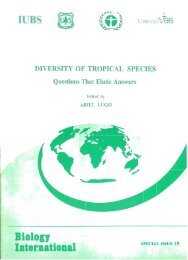SPECIAL ISSUE 34a.pdf - Biology International
SPECIAL ISSUE 34a.pdf - Biology International
SPECIAL ISSUE 34a.pdf - Biology International
Create successful ePaper yourself
Turn your PDF publications into a flip-book with our unique Google optimized e-Paper software.
<strong>Biology</strong> <strong>International</strong> Special Issue No. 34 (1997)<br />
During 1996 the current draft was published in Taxon (45:.349-372) and the<br />
Bulletin of Zoological Nomenclature (53: 148-166), and was made available<br />
on the World Wide Web (http://www.rom.on.ca/ebuff/ biocode.htm); it was<br />
also distributed to participants at the <strong>International</strong> Congress of Systematic and<br />
Evolutionary <strong>Biology</strong> in Budapest, and those attending nomenclatural comm-<br />
ittee meetings at the IUMS Congress in Jerusalem. The draft is a tentative<br />
working document and needs not only fixther revision and development but a<br />
glossary, appendices and illustrative examples. It is nevertheless the product<br />
of many hours of what has been, for the participants, a process of mutual edu-<br />
cation (see Chapter 2).<br />
One of the aims of the BioCode project is the harmonization of terminology<br />
across the whole field of taxonomic nomenclature, and during the discussions<br />
the first lesson learned was that while the existing Codes share most principles<br />
in common the terms used are (even in the English language alone) very<br />
different. In some cases the words employed are not self-explanatory, and<br />
they may be deceptive (for instance many "available" zoological narnes are<br />
not available for use). Even the word "name" itself is not equivalent in the<br />
present Codes: while in the zoological Code it is used only in the normal<br />
sense, in the Botanical one it also has the meaning [as in the expression "type<br />
of a name"] of the zoologists' nominal taxon, i.e. a taxonomic concept denoted<br />
by a name. The attached Table is reproduced from the draft BioCode and<br />
shows suggested ways in which some of these ambiguities may be overcome.<br />
In an enviable example of decisive action the proposed terminology has been<br />
incorporated in the 1996 edition of the <strong>International</strong> Code of Nomenclature<br />
for Cultivated Plants (see Ch. ??).<br />
The layout of the draft BioCode conforms more to the botanical Code than to<br />
the zoological one, because an electronic copy of the former served as a<br />
template during the discussions, but many of the provisions are of<br />
"zoological" origin. Perhaps the most noteworthy example (at least for<br />
botanists) is the adoption of the so-called principle of coordination. This<br />
concerns three "groups" of nominal taxa (the family-, genus- and species-<br />
groups); a name established in one of these for a taxon at a particular rank is<br />
deemed to have been established also at al1 other ranks in that group. Thus a<br />
name applied to a genus is automatically established also at subgeneric rank,<br />
and vice versa (Art. 29), and a name for a subfamily is simultaneously<br />
established (with appropriate change in ending) for a family and for any other<br />
ranks (e.g. tribe) in the family-group (Art. 27). The same situation applies to<br />
specific and subspecific epithets (Art. 31). The principle results in a taxon<br />
keeping the same name regardless of the ranks accorded in the opinions of<br />
different workers, and its absence from the Botanical Code is one of the main<br />
differences between that Code and the Zoological one.<br />
Another major difference between those Codes is the treatment of species-<br />
group epithets when, as a result of taxonomic opinion, two taxa whose names<br />
include the same epithet are placed in the same genus (see also Chapter 2).<br />
Clearly one or other epithet has to be replaced to avoid homonymy. In zoolog-<br />
ical practice the precedence of epithets is determined by their dates of original




